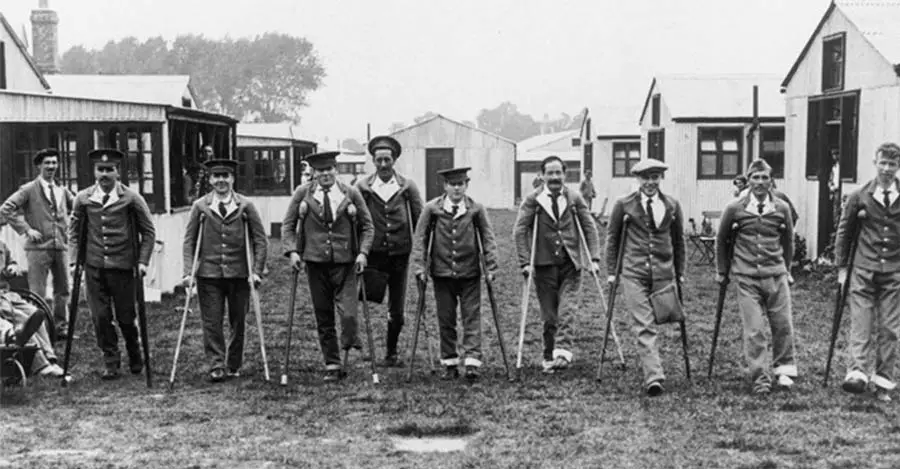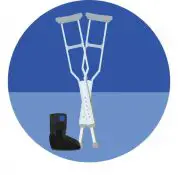History And Development Of Crutches
According to the WHO, people worldwide are living longer. It makes sense that more people will need to use crutches at some point in their lives. This is because of injuries, disease, or age-related mobility issues.
For centuries, people have been using crutches to help with various mobility problems. Yet, few people know much about the history and development of these mobility aids. As crutches become more prominent in day-to-day life, it’s important to know more about them.
We spent hours researching the medical history of crutches. That’s why our article will talk about the history and development of crutches.
History Of Crutches
It might come as a surprise, but the history of how crutches came to be is interesting and impactful to society.
Without the invention of crutches, many people would struggle to recover from injuries. Many would also struggle with illnesses and diseases that affect their mobility.
When Were The First Crutches Invented?

The earliest known recording of people using crutches was during the Egyptian period. This was around 3,000 BCE. According to studies, art depicted the use of crutches in ancient texts during this time. Experts who study medical history have stated something interesting.
The main goal of crutches was to restore the functionality of a person who lost a limb as close as possible. Additionally, it’s known that crutches are the oldest tool used by orthopaedists globally.
What Did The First Crutches Look Like?
Many people believe that the earliest crutches were a T shape design. As time goes on, the T shape changed into the V-shape used today.
The first crutch was hardwood cut to length and split near their tops to create a V-shape. Often an underarm piece could attach so that people could use them as crutches.
These first crutches lacked the cushioning needed to be comfortable for users. Yet, they were functional and a big help to those who needed them in the past.
When Were The First Crutches Used?
The first recorded use of crutches was during the Egyptian period. Many believe that one of the Pharaohs used crutches, which proven a carving dating back to 3,000 BCE.

Did Crutches Exist In Medieval Times?
Often many people ask if crutches existed in Medieval times, and the answer to this question is yes. Many historical texts have depicted crutch use through art and the written word. This is especially true for documents dating back to medieval times.
In fact, during medieval times, crutches went through their next stage of development. During this development, people added padding. Accounts have proven that leather would be strung atop crutches. This was, so armpit contact was less hurtful.
Soon after this development, another occurred. People added horsehair to create a padded section. This padded section had leather placed atop the horsehair. Many experts believe medieval crutch handles were also padded to some extent.
The Invention And Development Of Underarm Or Auxilary Crutches
Now that you know a little more about the rich and interesting history of crutches, it’s time to delve deeper. Below we speak about the invention and development of underarm (auxiliary) crutches.
Who Invented Underarm Crutches?

It isn’t known who invented underarm crutches. Yet it’s known that they were often used during medieval times. Many people would make their own crutches when they were suffering an ailment. These were T-shaped, as we mentioned earlier.
They have been around for centuries. But there hasn’t been much improvement to their design. Yet, they feature better materials. They are also far more durable, versatile, and comfortable.
What Is The Purpose of Underarm Crutches?
Those recovering from an injury or surgery use underarm crutches in the past and present. Yet, underarm crutches have an array of problems. These issues include increasing people’s heart rates and pinching nerves. So you should only use them for short periods.
Usually, a medical professional will say to use underarm crutches for one to three months. Despite their known problems, there are benefits. For example, underarm crutches need less upper body strength and body control.
Popular Areas Of Use

You will use underarm crutches when recovering from leg, ankle, or foot injuries. These crutches are for short-term recovery. They are not usually meant for an ongoing mobility aid.
Yet, since these crutches are easy to learn, they are readily available. Millions of people use them each year who have minor injuries.
According to a study, it’s believed that underarm crutches are often used in America the most. This is when compared to the countries that favor forearm crutches.
The Invention And Development Of Forearm Crutches
As we did above, we will discuss the invention and development of forearm crutches. These crutches are becoming popular. They have fewer problems associated with them.
Forearm crutches have gone through development. These developments make them more comfortable than underarm crutches. There are different forearm crutches for different injury types, age groups, and genders.
Who Invented Forearm Crutches

The modern underarm crutches were invented and patented by Emile Schlicke in 1917.
These forearm crutches were the first crutches sold commercially. The first forearm crutches were mass-produced in New England in the United States.
Schlicke’s design involved a protruding handle situated at hip height. It also had a slanting top section and a metal cuff surrounding a user’s forearm. These crutches were widely utilized during the first world war. This is unsurprising considering the huge demand for mobility aids during this time.
Some years later, the next technical advance in the development of crutches occurred. Anders R Lofstrand was responsible for changing the original design. He amended the design to be more useful to those who needed to use these mobility devices.
Years later, in the 1950s, another development in forearm crutches occurred. An American polio sufferer named Thomas Fetterman changed the design of forearm crutches. He knew firsthand how important forearm crutches were to those with mobility issues.
He made crutches with titanium and shock-absorbing rubber feet to improve forearm crutches. This was an industry first and improved user comfort and paved the way for modern crutch design.
What Is The Purpose Of Forearm Crutches
Unlike underarm crutches, forearm crutches are primarily used as a long-term mobility aid. These crutches are often used by those with a disability involving their legs.
To use forearm crutches, you will need more upper body strength. Yet, once you get used to forearm crutches, you will usually find them much easier to use.
Popular Areas Of Use
In the past, soldiers used forearm crutches. Those recovering from ligament tears, broken legs, sprains, and amputations used them. Forearm crutches gave soldiers back some of their mobility. They also helped them relearn how to complete daily tasks and live a normal life.
Today, those who need a mobility aid for a long or undetermined period use forearm crutches. Usually, those who have an injury that needs to heal for a few weeks or months will use forearm crutches. People with disabilities like arthritis and other chronic conditions will use forearm crutches.
The same study that looked at underarm crutch use did the same for forearm crutches. The findings revealed that most countries in the world use forearm crutches. These countries include Argentina, Australia, New Zealand, and the UK.
Final Word
As you can tell, the history and development of crutches is interesting and vital to know. Many people with injuries, illnesses, and chronic conditions would suffer without crutches.
If you’re someone who needs crutches, you can have a look at our underarm crutches review. You should also look at our forearm crutches review. We hope our reviews will help you find the crutch set that best suits your needs and preferences.
